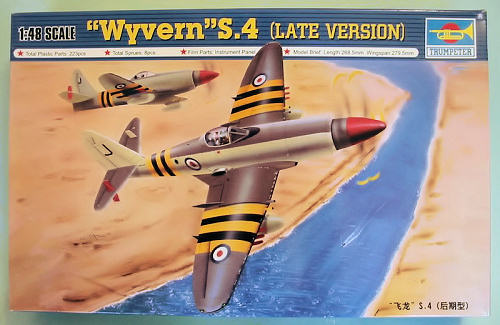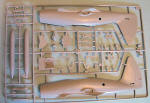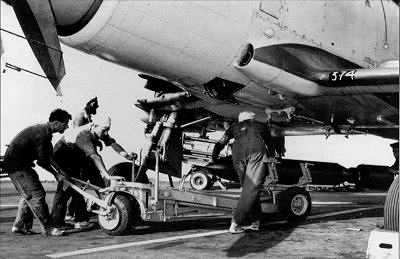
| KIT: | Trumpeter 1/48 Wyvern S.4 |
| KIT #: | 2820 |
| PRICE: | $54.95 |
| DECALS: | Three options |
| REVIEWER: | Tom Cleaver |
| NOTES: |

| HISTORY |
One major change in naval aircraft during the Second World War was the development of a single-seat strike fighter that could take on both the role of dive-bomber and torpedo-strike. In the U.S. Navy, this development led to the Douglas Skyraider, one of the most successful naval aircraft ever built; in the Royal Navy it resulted in the Westland Wyvern, which was surely one of the most frustrating naval aircraft ever built, an airplane that took ten years to bring to operational readiness, only to be declared obsolete within four years of its initial arrival on British decks.
W.E.W. “Teddy” Petter began development of what would become the Wyvern as his last project at Westland before leaving for English Electric where he would design his masterpiece, the Canberra jet bomber. Petter’s objective was to develop a long-range carrier-based day fighter with the ability to carry a torpedo or bombs as appropriate for a secondary role as an anti-shipping strike aircraft. The original design would have had the engine mounted amidships, a layout that had been tried for the Westland F.7/30 prototype of 1934. The favored engine at this point was the Rolls-Royce Eagle, a 24-cylinder liquid-cooled “H” type like the Napier Sabre, designed for an ultimate output of 3,500 horsepower. Further development was made official when the Naval Staff issued specification N.11/44, written around the Westland proposal. A mockup with the mid-mounted engine and nose-mounted cockpit found little support from the service pilots who would fly it, so a second mockup was created with the engine in the nose and the cockpit atop a significant hump in order to obtain a 15-degree angle of view over the nose for deck landing. By June 1944, the design was known as the W.34, though it was officially known as the N.11/44 until the adoption of the name “Wyvern” in 1947.
By August 1944, Westland began investigating the possibility of changing the powerplant to a turboprop. However, six Eagle-powered prototypes were ordered in November 1944. The planned turboprop was the Rolls-Royce RB.39 Clyde, which Rolls-Royce expected to deliver in December 1945.
The N.11/44 prototype, which was the biggest British single-seat naval fighter type at the time, required a double fold of the wing, with the tips folding down in order to have clearance on the hangar decks of RN carriers. In order to launch from a deck, the airplane required a contraprop, which was developed by Rotol (8-blade) and DeHavilland (6 blade). This in turn led to a very large vertical fin to provide directional stability.
With the end of the war, Rolls-Royce was directed to cease further development of the Eagle and concentrate on gas turbine development. A pre-production batch of 20 N.11/44s would be Eagle-powered, becoming the Wyvern Mk.1, while all further development would be centered around turboprop powerplants.
The first prototype N.11/44 flew on December 16, 1946. Six other prototypes appeared in 1947-48, with the pre-production Wyvern Mk.1s produced in 1949. Useful work with the Mk.1s resulted in spring-tab control surfaces that greatly improved maneuverability. Only five Mk.1s were used for this work.
The first Turboprop Wyvern, the N.12/45 prototype flew on January 16, 1949, powered by a R-R Clyde. While the Clyde exceeded initial performance estimates, it suffered from a variety of problems, not the least of which was that Rolls-Royce was committed to other engine projects, which kept them from focusing on solving the Clyde’s problems. The Armstrong-Siddeley Python was the only turboprop of the necessary power that could be used for the Wyvern. This change added at least two years to the development cycle as the engineers struggled to create a throttle control that would allow the engine to be rapidly throttled back for a carrier landing, or rapidly throttled up to make a go-around, the solution being an inertia control unit that was, unfortunately, mechanically complex.
The Wyvern finally appeared from development as the S.Mk.4, and began to be delivered to RNAS Ford in May 1953 to equip 813 Squadron. These aircraft did not have the definitive engine control unit and thus were not carrier-compatible until these units were installed in the summer of 1954. The first operational Wyverns went aboard HMS Albion in September 1954, where it was discovered their problems were not over, as there were a series of flameouts during catapult launch as a result of fuel starvation under high-g loading while the aircraft were with Albion during a Mediterranean cruise. The Wyverns were offloaded at Hal Far, Malta, and remained there until March 1955 when they returned to England. A final design of the ICU/ECU unit solved the flameout problem. 813 and 827 Squadrons embarked aboard HMS Eagle in May 1955 for a second Mediterranean cruise, which gave the Wyverns some 1,500 operating hours and 1,000 landings, after which the aircraft was considered proven.
The final modifications of the S.Mk.4 appeared in early 1956. This was visually identifiable by the removal of the curved windscreen over the flat armored glass, a strengthened canopy with a more extensive metal frame, and dive brakes added under the wing center section. The result was an airplane that still didn’t provide the performance that was needed, and only continued on operations due to the fact there was no alternative. The airplane was so short-ranged that it needed a large centerline fuel tank in addition to the wing tanks, which meant it could not carry a torpedo, and when it was carrying enough fuel to have an adequate range, it could not get off a carrier deck even with a catapult while carrying its maximum ordnance load, thus requiring the use of RATOG units to get the Wyvern airborne.
813 and 827 Squadrons returned from the Mediterranean and decommissioned in November 1955. They were replaced by 830 and 831 Squadrons which activated in January 1956. 830 Squadron went aboard HMS Eagle that May, destined to be the only unit to fly the Wyvern in combat, when their nine aircraft participated in six days of strikes against Egyptian military targets in the Suez Canal Zone in October-November 1956 as part of Operation Musketeer, the Anglo-French “intervention” in what was called “the Sinai War,” though that was really part of a conspiracy by the two western powers, working with Israel, to regain control of the Suez Canal following its nationalization by Egypt in 1955.
813 recommissioned in October 1956, giving the FAA three strike squadrons. With the decommissioning of 830 and 831 Squadrons in January and February 1957, 813 was the last Wyvern operational unit, embarking on HMS Eagle in July 1957 for a tour that lasted until March 1958. 813 decommissioned at Ford on March 29, 1958, which marked the end of active service for the Wyvern. 33 had been lost to all causes during its operational life. The survivors were all melted down during 1959, and the only Wyvern in existence today is the Wyvern Mk.1 VR137, which was never actually flown.
The Westland Wyvern suffered an extended developmental period due to the fact it was one of the first aircraft to use the then-new turboprop. Almost all of the basic technological development that would make later turboprops efficient and reliable was accomplished in this program, which may be the Wyvern’s greatest contribution to aeronautical development.
| THE KIT |
 The Wyvern has been a favorite of mine ever since as a wee young aeronut I
picked up “The Aircraft of the World” by William Green and Gordon Swanborough at
the local library in 1954. The book was an eye-opener: the first I had found
with detailed information and photographs of airplanes, and some of them even
had detailed three-view drawings; thus was I introduced to good technical
aviation history by two of the best writers ever (one of whom I would work for
25 years later). One of the airplanes deemed deserving of those newfangled
three-view drawings was something called the Westland Wyvern. I didn’t know a
thing about it other than I just liked its look. I still do - a Wyvern is a
mythological dragon, and the airplane has a very dragon-like look to me. I
laugh every time I think of the Very Well Known Modeler who took a look at one
of the many Wyvern models I’ve made over the years (this one being the ID Models
vacuform) at the 1988 IPMS Nats and proclaimed it a “what-if” model that didn’t
belong in the 1/48 Naval Aircraft category since something that looked like that
could never have been actually produced. So much for Model Gnus.
The Wyvern has been a favorite of mine ever since as a wee young aeronut I
picked up “The Aircraft of the World” by William Green and Gordon Swanborough at
the local library in 1954. The book was an eye-opener: the first I had found
with detailed information and photographs of airplanes, and some of them even
had detailed three-view drawings; thus was I introduced to good technical
aviation history by two of the best writers ever (one of whom I would work for
25 years later). One of the airplanes deemed deserving of those newfangled
three-view drawings was something called the Westland Wyvern. I didn’t know a
thing about it other than I just liked its look. I still do - a Wyvern is a
mythological dragon, and the airplane has a very dragon-like look to me. I
laugh every time I think of the Very Well Known Modeler who took a look at one
of the many Wyvern models I’ve made over the years (this one being the ID Models
vacuform) at the 1988 IPMS Nats and proclaimed it a “what-if” model that didn’t
belong in the 1/48 Naval Aircraft category since something that looked like that
could never have been actually produced. So much for Model Gnus.
In 1/48, there have been three previous kits of the Wyvern.
Two of these were vacuforms, one by ID Models that has long been superseded b the other - a very advanced vacuform that provides everything a modeler needs to create a beautiful model, produced by Dynavector. With the addition of the Compass Rose resin cockpit designed by Roy Sutherland, it’s a kit that’s still hard to beat. Two years ago, Classic Airframes produced a limited run Wyvern, which built up as the definitive late-production S.Mk.4, with the added-on dive brakes on the lower wing center section, the wing fences inboard of the ailerons to prevent aileron snatch, the late production windscreen with the flat armor glass, and the late canopy with the metal framing for strength.
 All
of these kits are now bested by this new release from Trumpeter. The kit comes
on five light grey sprues of airframe parts, a sprue of parts for the gearing of
the contra-rotating props, and a sprue of clear plastic for the separate canopy
and windshield, camera ports and navigation lights. There are a total of 220
parts, which include all the ordnance the airplane was ever supposed to carry,
including rockets, 1,000-lb bombs, a torpedo, the centerline tank and the two
wing tanks, as well as the RATOG units. The kit makes up as a late-version S.
Mk.4.
All
of these kits are now bested by this new release from Trumpeter. The kit comes
on five light grey sprues of airframe parts, a sprue of parts for the gearing of
the contra-rotating props, and a sprue of clear plastic for the separate canopy
and windshield, camera ports and navigation lights. There are a total of 220
parts, which include all the ordnance the airplane was ever supposed to carry,
including rockets, 1,000-lb bombs, a torpedo, the centerline tank and the two
wing tanks, as well as the RATOG units. The kit makes up as a late-version S.
Mk.4.
The kit has beautiful restrained surface detail, which is not inaccurate at all, as the accompanying photograph here of a real Wyvern demonstrates.
 The kit decals are
excellent, and provide for three Wyverns: WN325 from 830 Squadron aboard HMS
Eagle during Operation Musketeer, WL879 of 813 Squadron during the unit’s
final deployment aboard HMS Eagle in 1958, and WN335 of 831 Squadron
aboard HMS Ark Royal in 1957. All stencils are provided, as well as nose
art for each airplane. The national insignia are the correct size and color.
The yellow and black “invasion stripes” are provided as decals for those
“stripe-challenged” modelers - these are very good, in fact their look will be
“too good” for these hastily-applied temporary stripes, and I for one will be
painting mine.
The kit decals are
excellent, and provide for three Wyverns: WN325 from 830 Squadron aboard HMS
Eagle during Operation Musketeer, WL879 of 813 Squadron during the unit’s
final deployment aboard HMS Eagle in 1958, and WN335 of 831 Squadron
aboard HMS Ark Royal in 1957. All stencils are provided, as well as nose
art for each airplane. The national insignia are the correct size and color.
The yellow and black “invasion stripes” are provided as decals for those
“stripe-challenged” modelers - these are very good, in fact their look will be
“too good” for these hastily-applied temporary stripes, and I for one will be
painting mine.
The kit cockpit is nicely detailed. Since it is black, there’s not much there to be seen anyway, though one could obtain the Compass Rose cockpit and use it here. The kit seat is OK, with photoetch seatbelts provided and will look good when finished and installed, but I plan to use a resin seat as replacement. (Editor's note: I've only shown one sprue as representative of the kit in whole)
| CONCLUSIONS |
I can tell you now that this kit assembles as nicely as it looks. By the time you read this, mine will be coming out of the paint shop. Assembly is easy. The parts fit so well that this is one of the few kits I have built that has no putty or Mr. Surfacer on it anywhere. This is easily Trumpeter’s best kit yet, and can easily stand comparison with the best from Tamiya and Hasegawa.
I never, ever thought I would see a mainstream injection-molded kit of the Wyvern, and certainly not one of this superb quality. The only thing I can think of that would be better would be for Trumpeter to release a Wyvern of this quality in 1/32, to sit next to my soon-to-arrive Hawker Sea Fury by Paul Fisher.
Highly recommended. Buy in confidence. This is a kit that will make an average modeler look advanced, and an advanced modeler look expert with the resulting model.
September 2006
Review kit courtesy of Stevens International.
If you would like your product reviewed fairly and quickly by a site that has over 325,000 visitors a month, please contact me or see other details in the Note to Contributors.